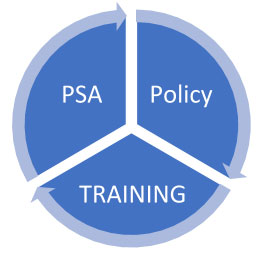Workplace Violence &
Active Threat Preparedness
Every year, thousands of American workers report having being victims of workplace violence.
Each year the U.S. workforce loses between 400-800 persons as a result of workplace homicide second only to traffic accidents as the cause of death.
Every year, thousands of American workers report having being victims of workplace violence. Each year the U.S. workforce loses between 400-800 persons as a result of workplace homicide second only to traffic accidents as the cause of death.
Source – https://www.bls.gov/iif/oshwc/cfoi/workplace-homicides.htm
Reducing Risk and Liability:
Liability Overview
From a lay person perspective liability can be measured on any safety and security topic based on asking two questions.
- Can the need or should the need have been anticipated in advance?
- If so, what responsible preparation has your organization take to address that need?
After any natural man-made or natural disaster the organization needs to be able to demonstrate “due diligence preparedness” on that particular topic that occurred. Doing so requires one to specifically outline what “reasonable effort to prevent harm” did the organization take on that topic to achieve preparedness in advance.
Demonstrating this requirement should include an examination of three categories;
- Risk Assessment
- Policy & Procedure Development
- Training.
OSHA Compliance
There are currently no specific OSHA standards for workplace violence. However, under the General Duty Clause, Section 5(a)(1) of the Occupational Safety and Health Act of 1970, employers are required to provide their employees with a place of employment that is “free from recognized hazards that are causing or are likely to cause death or serious physical harm.” The courts have interpreted OSHA’s general duty clause to mean that an employer has a legal obligation to provide a workplace free of conditions or activities that either the employer or industry recognizes as hazardous and that cause, or are likely to cause, death or serious physical harm to employees when there is a feasible method to abate the hazard. OSHA has developed Enforcement Procedures and Scheduling for Occupational Exposure to Workplace Violence, which provides guidance and procedures to be followed when conducting inspections and issuing citations related to the occupational exposure to workplace violence.
The “Objection of Fear”
One of the objections we hear frequently on not wanting to prepare for this topic is that there is concern with leadership that if we educate and training our leadership and employees on this topic we will scare them or increase fear within the organization. Although this concern is certainly valid it does illustrate a fundamental misunderstanding of where “fear” comes from.
“Fear comes from having a Problem without a Solution!”
As an example of this misconception a person that is terrified of being around water when we examine the reasons for this most of the time it is determined that the person has never learned how to swim. The solution for this problem is to reduce fear of being around water by teaching them how to swim. The same fundamental applies to most people that are fearful about a given topic. Once we give our employees and leadership simple to implement solutions at their grass roots and individual level the result is actually a reduction of fear and anxiety, not an increase of such.
Workplace Violence Prevention and Solutions
Strategos employs a “3 Pronged Approach” to help organizations achieve “due diligence preparedness” on the threat of Workplace Violence.

PHASE #1 – Physical Security Assessment (PSA) with focus on Intruder Response:
One of the first steps in protecting any organization is to ensure that their facilities are not a soft target. Strategos International can provide a PSA for any organization to give custom and comprehensive Findings and Recommendations Report to improve overall facility security. Several factors are assessed to include controlled access, visitor management, security cameras, vulnerability, safe rooms, and other areas of improvement just to name a few. Pricing for a PSA is based on the number of building being assessed and the total square footage.
PHASE #2 – Workplace Violence Program Development:
The backbone of any WPZ program starts with a comprehensive policy and procedure manual. Strategos will work with your organization to customize a program that fits your needs and culture. This includes an on-site visit to gather information on organization goals and objectives, identify work environments, development of “safe room” and “get out” locations on floor-plan charts. This program includes the following:
- WPV Program Document
- WPV Program Policy
- Domestic Violence Response Policy
- WPV Incident Report Form
- High Risk Termination Policy
- Employee WPV Hazard Assessment
- Personal Conduct to Minimize Violence Handout
- Warning Signs of Escalating Behavior Handout
PHASE #3 – Training:
In a crisis, most people think they will rise to the occasion when in reality, they fall back to their training. Law Enforcement is on your side but will be minutes away in the best-case scenario. What will happen in the 4-10 minutes (or more) that it takes officers to arrive?
Hope is not a strategy, Preparation is.
Topics Covered
- History & demographics of armed and violent intruders
- Statistics of violent intruder events
- Psychology of the Armed Violent Intruder
- Differences & Commonalities of the Traditional vs. Ideological Attacker
- Leading Practices of High Risk Terminations
- “3 OUT” Intruder Response Model – Non-Linear Approach
- Lock OUT, Get OUT and Take OUT Principles & Techniques
- Overcoming “Normalcy Bias” Phenomenon
- Command & Crisis Communication Leadership
- Effective Sympathetic Nervous System Response
Other Services Offered:
Protection Services (short, intermediate, and long-term options) – Strategos International utilizes highly trained and professional protection specialist across the Continental United States (CONUS) and Outside the Continental United States (OCONUS). The majority of our protectors are current and former military and/or law enforcement officers. Protection Services include executive protection, workplace violence deterrence, high-risk terminations, plant or office closings, board meetings, and site security. Other services are available upon request.
